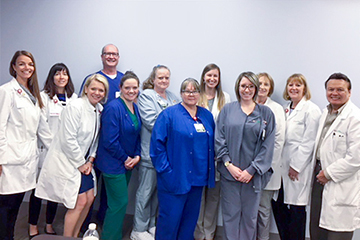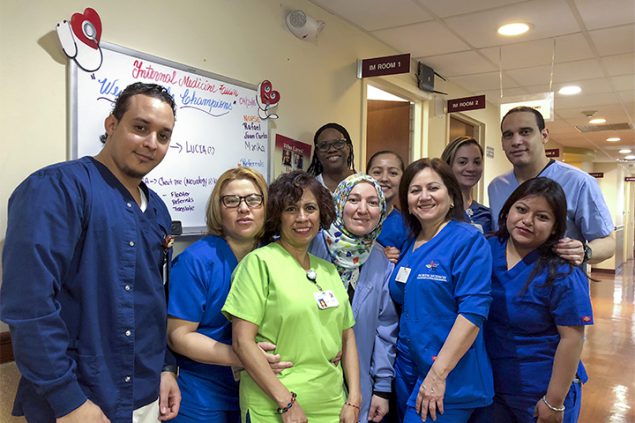Success Story: FQHCs Use a Medical Home Model for Underserved Populations
Lorain County Health & Dentistry (Lorain, Ohio) and North Hudson Community Action Corporation (West New York, New Jersey) (2017)
In previous rounds of the Hypertension Control Challenge, Million Hearts® established a benchmark of 70% hypertension control for applicants’ adult populations. This 2017 success story reflects the earlier benchmark.
The Opportunity

“Most people relate hypertension to older person’s disease, and this isn’t the case in our world.”
—Jennifer Casey, MD, chief medical officer, Lorain County Health & Dentistry
Federally Qualified Health Centers (FQHCs) are community-based organizations that are critical components of the health care landscape. They provide preventive and primary care services to people of all ages, regardless of ability to pay. Often, this means FQHCs treat people who are uninsured, underinsured, or underserved and who are most at risk for chronic diseases, such as high blood pressure.
Lorain County Health & Dentistry is an FQHC based in north-central Ohio that serves about 14,000 patients annually. Nearly two thirds of its patients are members of a racial or ethnic minority, and almost all are at or below 200% of the federal poverty line. North Hudson Community Action Corporation is the largest FQHC in New Jersey, with 10 locations in three counties. In 2017, it served more than 71,000 patients, about 70% of whom are not native English speakers. Nearly half of North Hudson’s patients are uninsured.
Successfully managing chronic conditions such as high blood pressure in these underserved populations can be a challenge. Language barriers, constantly changing phone numbers and addresses, and lack of transportation access are all issues that can hinder clinicians’ ability to successfully treat patients.
But Lorain County and North Hudson learned that using a special model of care that focuses on a team-based approach and creates patient ownership was the best way to help their communities control high blood pressure. “I think that’s been a key part of our ability to work within the patient population… [It’s] not just, ‘Here’s medicine and go on your way,’” said Jennifer Casey, MD, chief medical officer at Lorain County.
What They Did
In 2017, Lorain County’s blood pressure control rate was more than 83%; North Hudson’s rate was 77%. To reach these impressive targets, the FQHCs implemented the following tactics.

“Because we’re an FQHC, we’re the safety net, and we see a lot of sick patients. They’re coming in with multiple medical challenges and no prior care.”
—Flordeliz Panem, MD, chief medical officer, North Hudson Community Action Corporation
Adopted a “patient-centered medical home” model of care
Lorain County and North Hudson are certified to provide care under the patient-centered medical home (PCMH) model, which uses a coordinated, team-based approach to deliver comprehensive care across a variety of providers. For example, Lorain County is a multidisciplinary health center, offering services in women’s health, optometry, podiatry, primary care, pediatrics, and dentistry. Within each discipline, the health care team checks patients’ blood pressure, helping ensure no cases of hypertension are left hiding in plain sight.
The PCMH model ensures that the health care team performs a routine set of tasks designed to improve quality and outcomes. At North Hudson and Lorain County, each day begins with a morning “huddle” to discuss patients, schedules, and workflows. New patients complete a detailed intake form and answer questions about their behaviors, medical history, and more. If a patient’s blood pressure reading is high, a nurse will check again during that visit to make sure the reading is accurate. Any patient with a chronic disease, such as high blood pressure, must schedule a follow-up appointment before leaving the office.
Created patient ownership
Lorain County and North Hudson believe that patients must take responsibility for their health. The FQHCs encourage this by empowering patients to set self-management goals. These goals may include losing weight before the next appointment, incorporating more low sodium foods into their diet, or reaching lower blood pressure numbers. At each visit, a member of the health care team reviews the patient’s goals and progress, discusses barriers, and provides education.
Advice for Others
For other health care practices and systems that want to provide better blood pressure control for underserved populations, Lorain County and North Hudson recommend a few tips:
- Work with staff to maximize everyone’s abilities. For example, “Patients feel more comfortable working with medical assistants” than with physicians, said Flordeliz Panem, MD, chief medical officer at North Hudson. Dr. Casey echoes that every member of the team should be involved in patient care, regardless of who they are or what they do. “Our billers and accountants are as familiar with our quality numbers and goals as anyone,” she said. “Everyone needs to have ownership in care for the patient.”
- Educate patients and focus on their lifestyle goals. For example, North Hudson gives patients a printed list of their medicines and a summary of their visits. Nurses, counselors, or dietitians in both groups reinforce and track patients’ goals at each visit.
- Partner with other community organizations to ensure uninsured patients have access to all needed care. For example, North Hudson partners with a local ophthalmologist who can provide vision care. Lorain County partners with the local YMCA, which has a blood pressure monitoring program and can provide patients with home blood pressure monitors.
